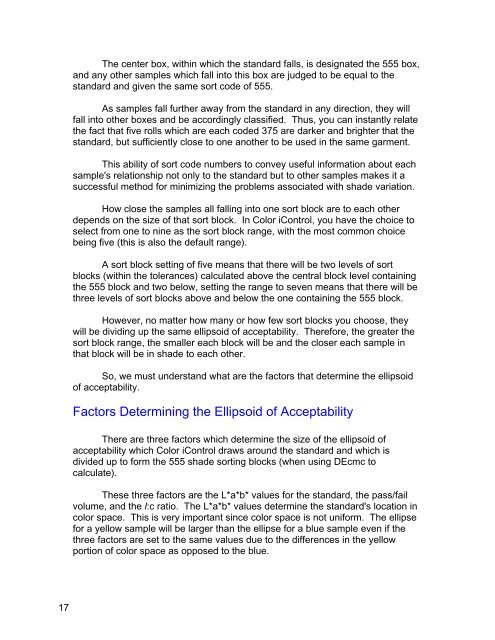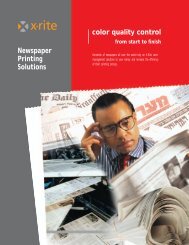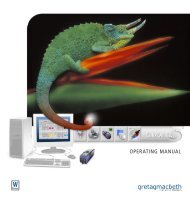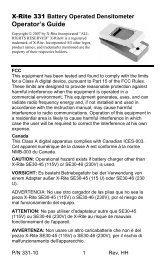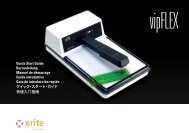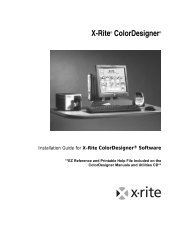Color iQC Help - X-Rite
Color iQC Help - X-Rite
Color iQC Help - X-Rite
You also want an ePaper? Increase the reach of your titles
YUMPU automatically turns print PDFs into web optimized ePapers that Google loves.
The center box, within which the standard falls, is designated the 555 box,<br />
and any other samples which fall into this box are judged to be equal to the<br />
standard and given the same sort code of 555.<br />
As samples fall further away from the standard in any direction, they will<br />
fall into other boxes and be accordingly classified. Thus, you can instantly relate<br />
the fact that five rolls which are each coded 375 are darker and brighter that the<br />
standard, but sufficiently close to one another to be used in the same garment.<br />
This ability of sort code numbers to convey useful information about each<br />
sample's relationship not only to the standard but to other samples makes it a<br />
successful method for minimizing the problems associated with shade variation.<br />
How close the samples all falling into one sort block are to each other<br />
depends on the size of that sort block. In <strong>Color</strong> iControl, you have the choice to<br />
select from one to nine as the sort block range, with the most common choice<br />
being five (this is also the default range).<br />
A sort block setting of five means that there will be two levels of sort<br />
blocks (within the tolerances) calculated above the central block level containing<br />
the 555 block and two below, setting the range to seven means that there will be<br />
three levels of sort blocks above and below the one containing the 555 block.<br />
However, no matter how many or how few sort blocks you choose, they<br />
will be dividing up the same ellipsoid of acceptability. Therefore, the greater the<br />
sort block range, the smaller each block will be and the closer each sample in<br />
that block will be in shade to each other.<br />
So, we must understand what are the factors that determine the ellipsoid<br />
of acceptability.<br />
Factors Determining the Ellipsoid of Acceptability<br />
There are three factors which determine the size of the ellipsoid of<br />
acceptability which <strong>Color</strong> iControl draws around the standard and which is<br />
divided up to form the 555 shade sorting blocks (when using DEcmc to<br />
calculate).<br />
These three factors are the L*a*b* values for the standard, the pass/fail<br />
volume, and the l:c ratio. The L*a*b* values determine the standard's location in<br />
color space. This is very important since color space is not uniform. The ellipse<br />
for a yellow sample will be larger than the ellipse for a blue sample even if the<br />
three factors are set to the same values due to the differences in the yellow<br />
portion of color space as opposed to the blue.<br />
17


